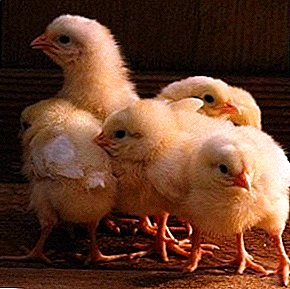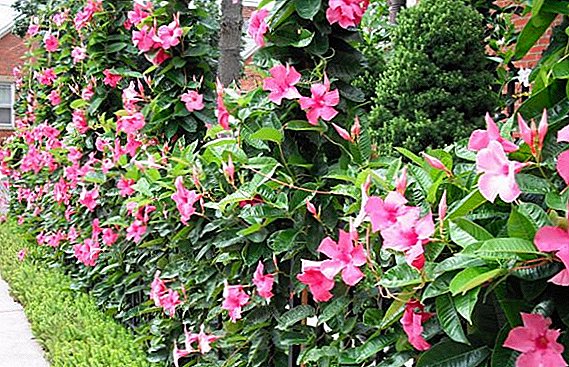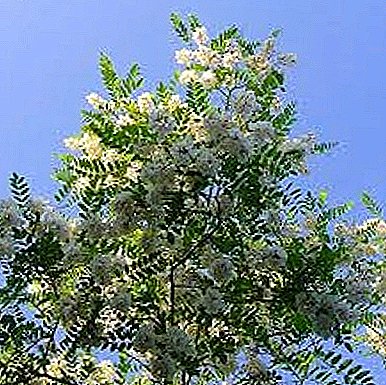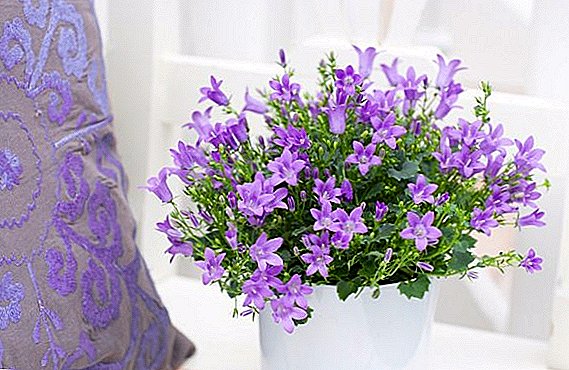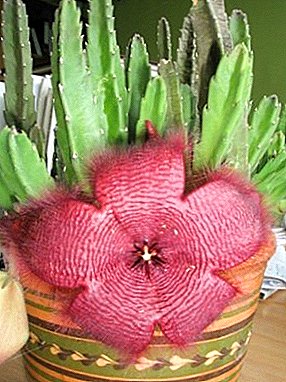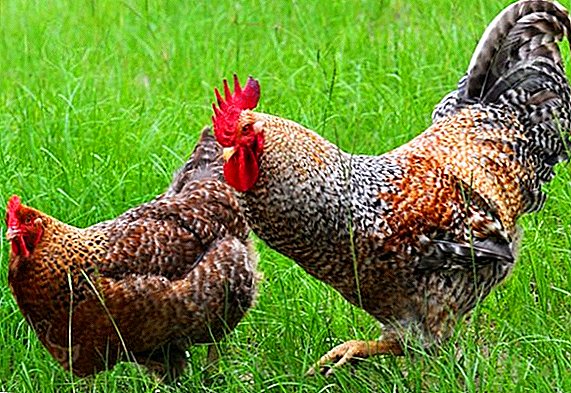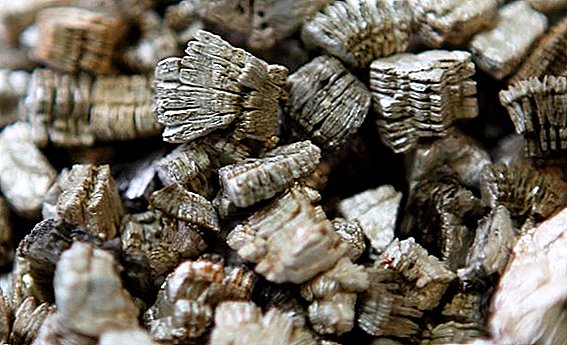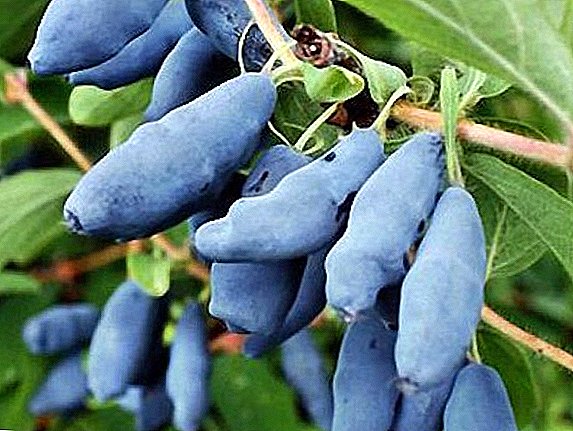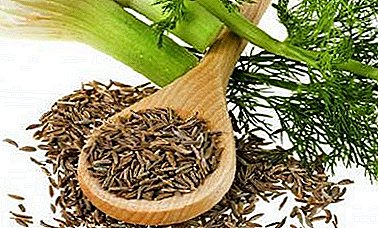
Classic gardeners grow potatoes, carrots, cucumbers, onions, etc. in their gardens. Experimental dacha residents try to diversify planting with exotic cultures. These cultures are not familiar to our taste, sight and hearing.
One of these plants is fennel. An umbrella-type plant (similar to dill) and very tall (up to 2 meters). Fennel is grown as a medicinal and food culture.
Consider in the article what it is - fennel, how to properly eat it, where you can add it as a spice, also give instructions on how to brew it and drink it for medicinal purposes.
What is it and what does it taste like?
 What does fennel taste like? The seeds and fennel tuber have a sweetish taste, while they are spicy with the smell of anise. Greens with dill flavor and aniseed notes. This is not surprising, since fennel is a relative of ordinary dill.
What does fennel taste like? The seeds and fennel tuber have a sweetish taste, while they are spicy with the smell of anise. Greens with dill flavor and aniseed notes. This is not surprising, since fennel is a relative of ordinary dill.
There are two food varieties of this plant: ordinary (to obtain leaves and seeds) and vegetable (head). The varieties of leaf fennel have a more pronounced smell and taste.
Vegetable varieties form kochanchiki instead of roots. For greenery, it is better to purchase seeds of the “Aroma” or “Autumn Beauty” varieties (it is distinguished by a bluish bloom on the leaves and a more tender aroma). To get bulbs for food, choose the varieties “Udalec” (onion up to 350 gr.) Or “Luzhnikovsky Semok” (onion up to 250 gr.).
What parts of a plant can I eat?
Economical housewives will love this plant, because almost everything goes into use and recycling. Where and how to use it in cooking?
| leaves | fresh, dried, salty |
| the seeds | fresh, dried, roasted, powdered |
| bulb | roasted, stewed, boiled and ground, pickled |
| stems | add when spinning vegetables, garnish |
| umbrellas | add when spinning vegetables |
There are no contraindications for the use of fennel, except for one - an allergy. But an allergic reaction is extremely rare. Due to the content of essential oils, doctors do not recommend using it to children under 4 months, pregnant women and people with epilepsy.
What does it eat?
What of it can be prepared at home, how and with what they eat this plant?
Raw
 Growing or buying fennel must be cleaned before use.. Separate the top leaf and stem from the root. Instructions for use of grass:
Growing or buying fennel must be cleaned before use.. Separate the top leaf and stem from the root. Instructions for use of grass:
- The leaves can be pure, pre-rinsed with water, added to salads, to meat or fish.
- Seeds eat 1-2 tsp. in a day. Use seeds for therapeutic and prophylactic purposes. Bonus to the listed - fresh breath.
Restrictions on the amount of consumption of the product per day is also not. If you follow the calculation of calories per day, then keep in mind: 100 gr. fennel seeds contain about 1.7% of the daily norm (from the WHO indicator of 2000-2200 kcal per day).
- At the root of the bulb must remove the top layer: hard and damaged leaves. The bulb is cut into four parts and removed the core, because it is tough and therefore not suitable for food. The remainder is cut into required pieces.
What does frequent use of a plant give? By consuming this plant systematically every day, you will get the desired results faster, and the effect will last longer.
If you decide to adhere to dietary therapeutic nutrition, or are overweight, then include this product in its raw form in your diet. It reduces the feeling of hunger and gives the body the necessary vitamins. Raw product can be eaten at any time, in the form of a decoction - before meals and at night.
Processed
- Boiled. An onion cut into several parts or a whole dipped in boiling water for 30-40 minutes. For dietary salt do not need to add. Broth after that, too, can be drunk. The bulb itself is cooled and rubbed through a sieve to form a soft gruel. It is used as a side dish.
- Fried. The onion is cut and fried in a pan. Preference is better to give olive oil for roasting.
- Dried. For drying, the leaves and seeds are laid out in a thin layer on paper and put in a dry, darkened place. When they dry, they are folded into a cloth bag for storage.
- Marinated. The bulbs are put in a jar, filled with marinade and left for storage in a cool place.
Fresh fennel is not stored for a long time: from 3 to 5 days in the refrigerator. Then he just loses the essential oils and beneficial properties. When fresh, it brings the most benefits to the body. During heat treatment (frying or boiling) it is necessary to take into account that some of the nutrients are lost. Dried fennel is added as a seasoning and can be stored for up to 6 months.
The most long-term storage option is pickling.. Although if there is a large freezer at home, it is possible to freeze the grass or bulbs for the winter, while retaining all the useful properties.
Use in cosmetology
 The current trend in cosmetology is the use of natural, natural cosmetics. It is best to use a decoction for cosmetic procedures.
The current trend in cosmetology is the use of natural, natural cosmetics. It is best to use a decoction for cosmetic procedures.
- A decoction of the seeds is suitable for the care of problem skin. The main action is anti-inflammatory. People with acne, dermatitis or eczema have the opportunity to improve the condition of the skin with compresses with decoction.
- Instead of special creams from dark circles under the eyes, the same decoction will do. Moisten cotton pads in broth and put on the eyelids for 10-15 minutes.
- With regular addition of fennel to food, the condition of the skin and hair improves. This is because the plant perfectly removes toxins, toxins and harmful substances from the body.
- Masks with fennel (for this you can make a slurry of seeds) is an excellent tool to protect the skin from harmful external influences: the sun, wind or cold. Due to the content of oils, they create a protective layer on the skin surface.
How is it used in medicine?
Different forms are used: tinctures, decoctions, powder, oil. Indications for use:
- Infusions are used to treat fungal diseases.
- Essential oil eliminates digestive problems. Oil can be used both in aromolamps and pendants. This smell calms, reduces anxiety, improves mood.
- Crushed dry leaves are a good expectorant. The composition of many natural cough remedies includes fennel.
- Broth recommend nursing mothers to improve lactation.
- A decoction of seeds buried in the eyes with conjunctivitis.
- Many people know the name "dill", it is the same broth. It helps get rid of colic and bloating.
Where to use in cooking?
It is worth trying this product in different dishes. It is used both as a vegetable and as a seasoning.
- Leaves and stem. The leaves are either added to salads fresh or dried. Fennel combines well in sweet and sour, sweet (fruit) salads. Dry and fresh leaves are used as seasoning for meat and fish dishes, added to soups to give aniseed flavor. Grass can be added to the marinade or pickles to give a pleasant smell.
 Seeds. Seeds as well as leaves are used as seasoning. Seeds can be sprinkled with baked goods, or simply added to the flour during kneading. If you use seeds not processed, the taste is more delicate, unobtrusive. During heat treatment, for example, roasting, the taste is revealed and becomes more pronounced.
Seeds. Seeds as well as leaves are used as seasoning. Seeds can be sprinkled with baked goods, or simply added to the flour during kneading. If you use seeds not processed, the taste is more delicate, unobtrusive. During heat treatment, for example, roasting, the taste is revealed and becomes more pronounced.- Stems. Stems and umbrellas thrifts housewives do not throw, but most often added to the marinade with other seasonings. For pickling cucumbers, zucchini and tomatoes, this green will also fit. And in Europe, the stems are cooked as asparagus: blanched and served chilled as a side dish.
- Onion or Kochanchik. This part is boiled, rubbed and used as a garnish. Independent dishes from fennel - baked halves or whole tubers. Pre-tubers can boil a little, and when baking sprinkle with cheese.
Recipes: how to use in food?
How to cook stew?
This vegetable dish can be cooked with fennel. Halves of vegetables are fried in a frying pan, garlic and salt are added, poured with wine, stewed for about 1 hour over low heat.
Sauce
It is made from one cobber, which is finely chopped and fried with the addition of garlic. Next, add 100 ml of dry vermouth and the same vegetable broth. After boiling, the pan is removed from the heat and whipped cream with one yolk is added. The sauce is put on a slow fire, stir and wait until thick. You can add chopped fennel leaves to the prepared sauce..
Meat
This product can be given anise flavor by cooking it with fennel.
- Take a large onion, cut it into equal halves.
- From one prepare the sauce as already described above.
- Cut the pork into pieces, fry and fry on both sides in a frying pan. When the pork produces juice, put it on a baking sheet and put in the oven to bake for another 20 minutes.
- On the remaining juice from the pork fry the second part of the onion, pre-cut it into layers.
- We take out the pork from the oven, put it on the fried fennel, pour the sauce on top.
Unusual taste gives fennel and chicken meat and fish.
How to brew tea?
From the ground seeds popular tea making. Although you can make a drink in the same way from the leaves.
- Approximately 1 tsp. seed is crushed and filled with a glass of boiling water.
- Infused tea 7-10 minutes.
When brewing tea, you can add other ingredients to the main, to taste: lemon balm, anise, cumin, Ivan-tea or chamomile.
For example, when brewing tea with chamomile equal proportions of herbs are taken: 1 tsp. fennel and 1 tsp Chamomile on a glass of boiling water.
Decoction
To prepare the decoction to 1 tbsp. seed is added half a liter of cold water and all this is brought to a boil. On a slow fire, the decoction lasts 20-30 minutes. After which it is cooled and filtered.
Store and use the decoction must be within 48 hours! Next is the process of formation of acids.
Tincture
To prepare the tincture, take 1 tbsp. roasted and slightly crushed (for example, rolling pin) seeds and poured from 1 l. vodka. Infusion time from 3 to 7 days. The color of the finished tincture is dark brown..
Salads
 You can add onions to salads without additional processing. Just fennel is cut into thin strips, apple and celery are also cut. Leaf lettuce and almonds can be added to sliced vegetables. A dressing for such a salad can be wine vinegar or olive oil. The hero of this article also goes well with:
You can add onions to salads without additional processing. Just fennel is cut into thin strips, apple and celery are also cut. Leaf lettuce and almonds can be added to sliced vegetables. A dressing for such a salad can be wine vinegar or olive oil. The hero of this article also goes well with:
- leek;
- tomatoes;
- green apples;
- celery;
- nuts (almonds, walnuts).
If you are a summer cottage experimenter, then select a piece of land on your plot for fennel. If you prefer traditional cultures, then think about it. After all this the culture is not only beautiful, easy in care and cultivation, but also useful. And how many delicious dishes you can cook with it. Not a plant, but a mistress's dream!


 Seeds. Seeds as well as leaves are used as seasoning. Seeds can be sprinkled with baked goods, or simply added to the flour during kneading. If you use seeds not processed, the taste is more delicate, unobtrusive. During heat treatment, for example, roasting, the taste is revealed and becomes more pronounced.
Seeds. Seeds as well as leaves are used as seasoning. Seeds can be sprinkled with baked goods, or simply added to the flour during kneading. If you use seeds not processed, the taste is more delicate, unobtrusive. During heat treatment, for example, roasting, the taste is revealed and becomes more pronounced.